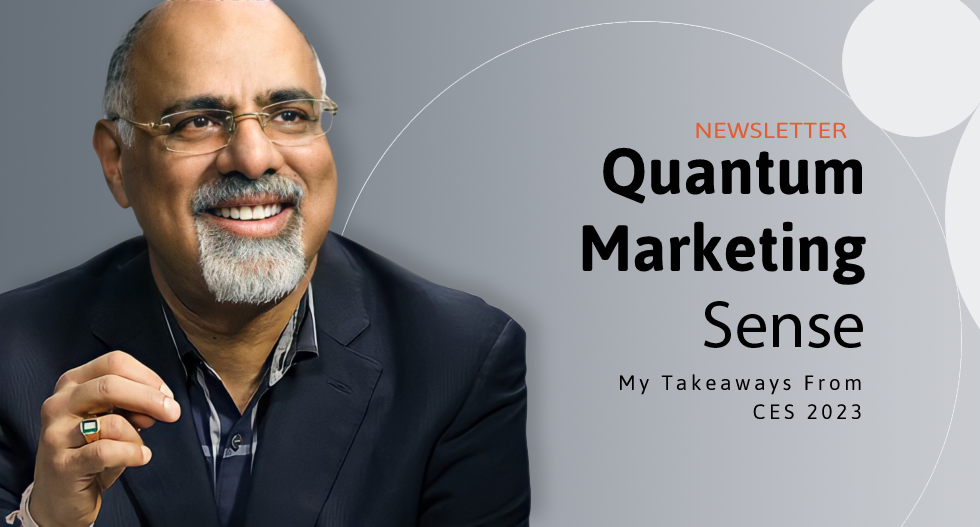The Topline
I have always been captivated by outer space. When I was a student, I won an essay-writing competition with a unique prize — a copy of the book “Chariots of the Gods?” by Erich von Daniken. The book sparked a lifelong passion for exploring all things extraterrestrial.
Last week, I was at CES 2023. While there was much to take away — which I will share with you here — I was particularly fascinated by a telescope that reignited my love for the cosmos.
The telescope, created by Unistellar, told you what was visible in the night sky in your location. It also allowed you to choose what you wanted to observe — after clicking the object of interest on your companion mobile device, the telescope changed and focused on that particular item in sharp focus. The guesswork was completely removed. A dream for casual space fans everywhere1
After arriving home, I had a realization: much like the telescope, CES itself was more focused and directed than ever before.
That’s a good thing for marketers. Let’s dive in.
The Essential Truth
I saw many interesting and exciting things while walking the CES floor. Here were some that I found most interesting.
New multisensory technology was in abundance.
− OVR Technology created a scent-filled wearable that pairs with desktops, mobile devices, gaming systems, and virtual reality devices — adding the sense of smell to experiences that had previously been only visual and auditory.
− Diver-X designed a glove for VR experiences that uses haptics to recreate the sensation of touch, while also removing the need for traditional controllers which can break the feeling of being immersed in a different reality.
− Nexteer’s Tactile Mobility showcased how cars can use road information to help drivers adjust to conditions, along with an early warning system that alerts the driver when they are losing attention.
− Marketing takeaway: As the real world and virtual worlds start to collide, multisensory elements can play a key role in marketing to engage consumers in totally immersive ways.
The digitization of health and wellness took center stage.
− Nuralogix created an app, Anura, which can report your vital signs, physiological and mental health, as well as overall health risks based on a 1-minute facial scan, on an iPad.
− Withings enabled at-home urine analysis with U-Scan, a toilet add-on that measures and tracks health information.
− SK Biopharmaceuticals released connected glasses that can detect and forecast seizures by measuring body movement, heart rhythm, and brain activity.
− Marketing takeaway: Using technology to democratize expertise is a trend that is likely here to stay. We need to rethink and reframe our products and services with that in mind.
Connectivity makes our lives easier — but introduces new challenges that marketers need to consider.
− Connected devices were everywhere. Any product you can think of: cars, refrigerators, toilets, lightbulbs, doorbells, plugs, switches, the list goes on and on.
− Marketing takeaway: As the amount of connected devices we own increases and they are constantly gathering data. It is critical that marketers and businesses be extremely cautious surrounding issues of data and privacy.
− Companies should never gather more data than they need, and they should get explicit permission from their customers regarding what data they are capturing and how it is being used.
− To do this effectively, marketers need to have rigorous data governance policies and processes in place.
The Tidbit
My biggest observation at CES was the shift to utility.
While there was certainly a noticeable amount of glitz and glamor, the primary focus was on how technology can actually improve people’s lives.
As noted above, a great example of this is what we saw in the health space, with many companies democratizing wellness through at-home tests and services. If adopted at scale, these technologies can radically change how we think about healthcare.
Our News at CES
For Mastercard, CES also marked an opportunity where we could drive the utility of technology for our customers.
That was the genesis behind the Mastercard Artist Accelerator — a new Web3-based platform designed to help assist and promote emerging musical artists in digital communities. The accelerator gives these artists the educational tools and resources they need to effectively use Web3 in their daily lives.
The program will connect select artists from around the world with notable mentors and a dynamic fanbase as they learn and create in Web3 — enabling a new dimension for content creation, collaboration and ownership.
By using these new Web3 technologies to provide tangible, practical benefits to our customers, we’re bringing them closer to the things they care about the most without intruding on their lives.
Long Story Short
One caveat for this newsletter — I am sharing the highlights from what I saw while walking the floors. I didn’t get a chance to see everything and I am sure there were incredible things that I missed. Unfortunately, that is all but certain at an event as large as CES.
Still, the theme for marketers was clear. The focus for 2023 is on the consumer, and how technology can truly enhance their lives, experiences, and wellbeing. It’s our job to tell that story effectively, so our customers can enjoy the benefits of recent innovations in a way that integrates seamlessly with their lives.
Did you see or read about anything of interest from CES? I’d love to hear about it in the comments.

Recent Comments